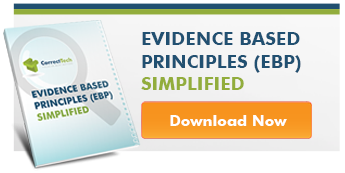We have another article from Dr. Alexandra Walker we would like to share! We absolutely love this article she wrote and know it is helpful information for all you practitioners out there.
Read MoreFour Ways to Innovate in Criminal Justice NOW
Posted by Alexandra Walker, PhD on 4/8/20 7:00 AM
Topics: Community Corrections Professional, program results, EBP, Criminal Justice Reform, innovation, Fidelity, Reforms, Outcomes, Implementation
Risk Reduction: Be Positive
Posted by Raymond Chip Tafrate, PhD, Damon Mitchell, PhD, & David J. Simourd, PhD on 9/19/19 3:00 PM
What works and doesn’t work when using Cognitive-behavioral therapy (CBT)? This is something the authors, Raymond Chip Tafrate, PhD, Damon Mitchell, PhD, & David J. Simourd, PhD, of this blog series have spent a long time studying and have put all they’ve learned in the book: CBT with Justice-Involved Clients: Interventions for antisocial and self-destructive behaviors. We thought our subscribers would be interested in a blog series on this content, knowing so many use or refer their clients to this type of treatment. Therefore, we are pleased to announce this blog series on Adapting CBT for Justice-Involved Clients.
Let’s face it, much of what occurs in criminal justice is negative. Justice-involved clients (JICs) commit crimes that challenge our sense of right and wrong and safety in the world. They also might resist supervision and intervention that is mandated to them by the courts. These and other issues can create a negative bias against JICs and their ability to improve themselves. Additionally, the contemporary models of rehabilitation are based on risk reduction and risk models that get a bad rap. It can be common for community corrections officers and case managers to be reluctant to embrace a risk reduction perspective with JICs because it is viewed as intrinsically pessimistic and deficit-driven. Practitioners often say that working from a risk framework emphasizes client failures and problems, and the assessment process is simply a matter of adding up the number of risks a client has amassed. By extension, intervention is seen as establishing a set of avoidance goals based on those factors such as stay away from criminal companions and stop smoking pot. The reality is that risk-based models, when used effectively, offer a constructive perspective on client functioning, much more than just a checklist of JICs’ shortcomings. A shift towards a different, more multifaceted way of thinking about risk is often required to make these models useful for practitioners. We also suggest that risk models are the strategic heart of effective community corrections work.
Read MoreTopics: risk, Criminal Justice Reform
Risk: A “Four-Letter Word”
Posted by Harris Childers on 5/30/19 10:06 PM
We corrections professionals love to drop the r-bomb. I’m not talking about responsivity, although it is a critical component of EBP that is often neglected if not outright ignored. I’m talking about RISK, that four-letter word that precedes need every time we talk about supervising justice-involved individuals. Assessing criminogenic risk is fundamental to our mission; that’s a given. But what message do we send when we say someone is high risk? Are we poisoning the well, compounding the stigma, and adding barriers to achieving those other coveted “r-words” - rehabilitation, reintegration, and recidivism reduction?
Read MoreTopics: Evidence Based Practices, Risk Principle, responsivity, risk, EBP, Criminal Justice Reform
Subscribe To Our Blog
Recent Posts
Posts by Topic
- Community Corrections (62)
- Evidence Based Practices (44)
- Community Corrections Professional (23)
- Software (15)
- Practices (12)
- Change (11)
- Technology (10)
- Risk Principle (8)
- reentry (8)
- probation staff (7)
- EBP (6)
- Outcomes (6)
- client development (6)
- client needs and values (6)
- coaching community corrections clients (6)
- Assessment (5)
- Community (5)
- Developing a practice model (5)
- Justice-Involved Clients (5)
- Remote work (5)
- The Coaching Habit (5)
- parole (5)
- risk (5)
- tele-supervision (5)
- tele-work (5)
- Community Engagement (4)
- Evan C. Crist (4)
- Community Corrections Client Services (3)
- Criminal Justice Reform (3)
- Implementation (3)
- Listening Skills (3)
- Motivational Interviewing (3)
- Policy (3)
- Positive Reinforcement (3)
- Practice Models (3)
- high risk client (3)
- reaching clients emotions (3)
- responsivity (3)
- Addiction (2)
- BOP (2)
- Conferences (2)
- ICCA (2)
- Management (2)
- Michael Bungay Stanier (2)
- Relapse Prevention (2)
- halfway house (2)
- jic (2)
- principles (2)
- procedures (2)
- program results (2)
- APPA (1)
- Appreciative Thinking (1)
- Brian Lovins (1)
- COVID-10 (1)
- Community Connection (1)
- Coronavirus (1)
- Crisis (1)
- Customer Service (1)
- Data Management (1)
- Fidelity (1)
- ICCA Seattle (1)
- Juvenile Corrections (1)
- Leadership (1)
- Monitor History (1)
- Opioid Addiction (1)
- Opioid Crisis (1)
- Orange is the New Black (1)
- Program Data (1)
- Reforms (1)
- Relapse (1)
- Second Chances (1)
- Switch by the Heath Brothers (1)
- Treatment (1)
- drug testing (1)
- going paperless (1)
- govcio outlook (1)
- impact sessions (1)
- innovation (1)
- intrinsic motivation (1)
- justice reinvestment (1)
- marijuana testing (1)
- money savings (1)
- opiod testing (1)
- paperless office (1)
- purpose (1)
- remote working (1)
- resources (1)
- sanction (1)
- staff productivity (1)
- technology solutions provider (1)
- the awe question (1)
- what works (1)
- what's on your heart (1)
- work from home (1)





